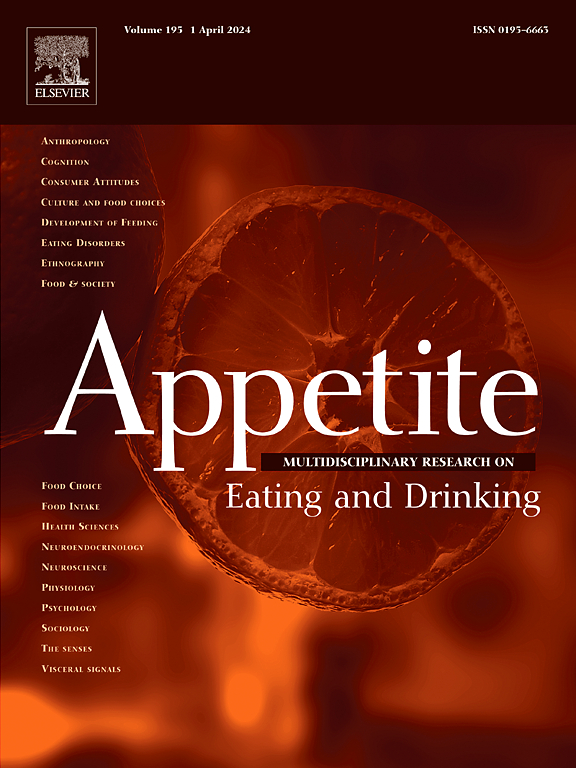参与以社区为基础的食品合作社影响澳大利亚成年人自我报告的食品安全状况和饮食摄入
IF 4.6
2区 医学
Q1 BEHAVIORAL SCIENCES
引用次数: 0
摘要
在快速通货膨胀中,越来越多的澳大利亚人在购买健康食品方面面临挑战,影响了饮食行为。以社区为基础的食品合作社是主流超市之外的一种新兴选择,可以获得更实惠的健康食品。本研究探讨了参与以社区为基础的食品合作社(Box Divvy)如何影响澳大利亚成年人自我报告的粮食不安全和水果和蔬菜摄入量。对Box Divvy成员进行的横断面在线调查测量了社会人口统计、水果和蔬菜摄入量(每周食用份数)和粮食安全状况(美国农业部6项简短表格),反映了他们在使用合作社之前和使用合作社期间的状况。参与者被分类为粮食安全或粮食不安全(轻度、中度和严重粮食不安全)。逻辑回归评估粮食不安全的人口预测因素,配对比例检验评估粮食安全状况的变化,方差分析检查饮食的变化。在参与者(n = 2277, 37%年龄在35-44岁之间,83%欧洲种族)中,50.8%的人在加入Box Divvy之前报告了粮食不安全(24.5%为边缘粮食不安全,18.4%为中度粮食不安全,7.9%为严重粮食不安全)。年龄较小、单亲家庭和收入较低是粮食不安全的重要预测因素。在使用Box Divvy时,报告粮食不安全的参与者比例要小得多(- 22.6%;95% ci: 20.7%, 24.5%;p & lt;0.001)。高水果(+2.5±5.6份/周p <;0.001)和蔬菜(+3.3±5.7份/周)(p <;0.001),中度和严重粮食不安全组与粮食安全组相比显著增加(p <;0.001)。我们的研究强调了社区粮食合作社如何通过改善获得健康食品的机会,对饮食行为和粮食安全产生积极影响。本文章由计算机程序翻译,如有差异,请以英文原文为准。

Participation in a community-based food cooperative impacts self-reported food security status and dietary intake in Australian adults
Amid rapid inflation, a growing number of Australians are experiencing challenges affording healthy food, impacting dietary behaviours. Community-based food cooperatives are an emerging alternative to mainstream supermarkets for accessing more affordable, healthy foods. This study explored how participation in a community-based food cooperative (Box Divvy) impacted self-reported food insecurity and fruit and vegetable intake among Australian adults. A cross-sectional online survey of Box Divvy members measured sociodemographics, fruit and vegetable intake (serves/week), and food security status (USDA 6-item short form) reflecting on their status before and while using the cooperative. Participants were classified as food secure, or food insecure (marginally, moderately, and severely food insecure). Logistic regression assessed demographic predictors of food insecurity, paired proportions tests assessed change in food security status and ANOVA examined changes in diet. Of participants (n = 2277, 37 % aged 35–44 years, 83 % European ethnicity), 50.8 % reported food insecurity before joining Box Divvy (24.5 % marginal, 18.4 % moderate and 7.9 % severe food insecurity). Younger age, single parent households and lower income were significant predictors of food insecurity. While using Box Divvy, a significantly smaller proportion of participants reported food insecurity (−22.6 %; 95 % CI: 20.7 %, 24.5 %; p < 0.001). Higher fruit (+2.5 ± 5.6 serves/week p < 0.001) and vegetable (+3.3 ± 5.7 serves/week (p < 0.001) intake was reported while using Box Divvy, which was significantly greater among moderately and severely food insecure groups compared to the food secure group (p < 0.001). Our study highlights how community-based food cooperatives can positively influence dietary behaviours and food security by improving access to healthy foods.
求助全文
通过发布文献求助,成功后即可免费获取论文全文。
去求助
来源期刊

Appetite
医学-行为科学
CiteScore
9.10
自引率
11.10%
发文量
566
审稿时长
13.4 weeks
期刊介绍:
Appetite is an international research journal specializing in cultural, social, psychological, sensory and physiological influences on the selection and intake of foods and drinks. It covers normal and disordered eating and drinking and welcomes studies of both human and non-human animal behaviour toward food. Appetite publishes research reports, reviews and commentaries. Thematic special issues appear regularly. From time to time the journal carries abstracts from professional meetings. Submissions to Appetite are expected to be based primarily on observations directly related to the selection and intake of foods and drinks; papers that are primarily focused on topics such as nutrition or obesity will not be considered unless they specifically make a novel scientific contribution to the understanding of appetite in line with the journal's aims and scope.
 求助内容:
求助内容: 应助结果提醒方式:
应助结果提醒方式:


